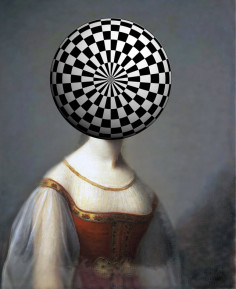THOMAS ROBSON
ТОМАС РОБСОН
توماس روبسون
トーマス・ロブソン

source: thvndermag
Thomas Robson es un artista británico que trabaja con imágenes apropiadas y collage digital. Con fotografías antiguas y cuadros de la época victoriana, el artista da un giro irónico desfigurando estas obras de artistas clásicos, ocultando las caras de los protagonistas, pixelando y glitcheando digitalmente las imágenes originales. Robson se refiere jocosamente al proceso de cubrir las caras de los sujetos como “el arte de la desfiguración”.
.
.
.
.
.
.
.
source: laughingsquid
“Art Remixer” Thomas Robson says he “develops collision art to confront received aesthetics & critically re-appraise imagery in a visually saturated world.” Whatever he says, the stuff is freaking cool. He has worked in graphic design and in interactive design for the web & TV for the BBC. But it seems like he’s more interested now in coloring outside the lines:
It is remarkable how diverse his work is in various series like Landscape with Data, Made in China and Luxe Art with styles and materials including collage, photography, computer graphics and even ceramics.
.
.
.
.
.
.
.
source: hifructose
Working with appropriated images and digital collage, UK artist Thomas Robson puts humorous spins on the portraiture of yore by obscuring the faces and bodies of the subjects with three-dimensional computerized graphics. Robson facetiously refers to the process of covering up the subjects’ faces as “the art of defacement” — most likely, in part, in anticipation of the criticism his work is bound to receive from traditionalists. Take a look at some of Robson’s work below.
.
.
.
.
.
.
.
.
source: fussedmag
Defacement or enhancement? That is one the more obvious problems that Thomas Robson’s artwork poses. Do we see his modifications as a form of digital vandalism, an avant-garde aggressive on visual high culture, or as a radical but positive reconfiguration of fine art?
Robson’s offensive on traditional portraiture is original and striking, undeniably. While sometimes he imitates splashes of gaudy paint across the pictures, these modifications are clearly the product of computer generation, and herein exists the real anxiety. The images exhibit temporal duality. They share ground in tradition and undergo the groundbreaking shocks of the digital age. This complicates interpretation somewhat, and we revert to our earlier question, in an alternate form. Should we approach these works as defaced fine art or as depthless symbols of the postmodern?
Note as well the location of these pixelated interventions. Some cover the face; others arch around it. Passing into the domain of art, personal identity becomes ambivalent, itself double-faced. Robson thereby challenges the stability that portraiture was meant to confer on the sitter. The artistic methods likewise prove antithetical. The dextrous and deliberate work required to create accurate portraits seems at odds with the apparently random application of shapes and colours.
Rare is it that we find such conflict focused in one artwork. Often we search for unities amidst the disjuncture, harmony among discord, but through the sheer contradiction of these images, Robson sets out a genuine challenge to our interpretative skills.

